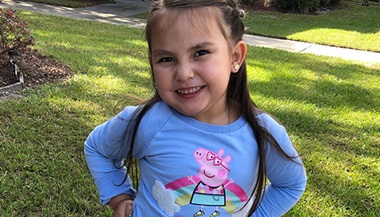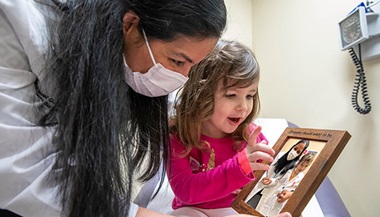Patient Story
Gastroschisis: Andres’ Story
Patient Story Highlights
- Baby Andres was born at 35-weeks gestation with a prenatal diagnosis of complex gastroschisis, a birth defect that occurs when a baby's intestines protrude through a hole in the abdominal wall.
- Because of the way Andres’ intestines had developed in utero, surgical intervention was needed right in the delivery room for Andres to be delivered.
- Andres was critical and fragile when he was taken to the neonatal intensive care unit, but after an 8-month stay in the NICU, his family was able to bring him home.

For more than 30 years, pediatric surgeon Paul Danielson, M.D. at Johns Hopkins All Children's Hospital in St. Petersburg, Florida, has often been called in the middle of the night to perform lifesaving surgery. But when baby Andres was born on April 16, 2022, at 35-weeks gestation with a prenatal diagnosis of complex gastroschisis, it turned out to be a surgical scenario that Danielson had never before experienced in his medical career.
Gastroschisis is a birth defect that occurs when a baby's intestines protrude through a hole in the abdominal wall. The muscles and skin that cover the baby's belly do not form completely before birth. This causes the baby's intestines to poke through the opening in their belly.
When Danielson arrived at Bayfront Baby Place (a department of Bayfront Health St. Petersburg but located within Johns Hopkins All Children’s Hospital), he quickly realized that this was not a routine gastroschisis case. Andres’ intestines not only developed outside the abdominal cavity but were adhered firmly to his mother‘s placenta, requiring surgical intervention right in the delivery room to transect the intestines in order for the baby to be delivered.
“I did not have much time to prep for surgery or move mom and baby to an OR,” says Danielson, chair of the Department of Surgery and associate dean of clinical affairs at the St. Petersburg, Florida, hospital. “We had a situation where the baby was stuck in the birth canal (it was anticipated to be a routine vaginal delivery), and I had to reach up through the birth canal to divide the nonviable intestine that was tethering the baby. In essence, I had to cut it to get him out. The neonatologists attending the birth had intubated the baby when he was only partially born, which was an amazing feat.
“Working at a children’s hospital, we see gastroschisis cases quite frequently. But a scenario where the intestines adhere to the placenta, and the baby can’t be delivered, is very, very rare, and that’s what we were dealing with in this case.”
“When I was 15 weeks pregnant, we had some blood tests come back that showed I had abnormal hormone levels out of balance,” says Andres’ mother, Allison. “An anatomy scan confirmed it was gastroschisis. It could have been a number of other things much worse. We were told to be thankful that’s what it is.”
“I cried a lot after getting the news,” she says. “I got on the computer and started searching for gastroschisis stories to learn more.
“Doctors explained to me that there was a routine surgical plan to get the intestines back in the baby's body as soon as possible after birth. I was told I could expect a fairly normal pregnancy and would most likely deliver at 37 weeks with a short hospital stay for the baby.”
But that’s not exactly what played out in Allison’s case.
‘It Was Scary’
“The baby basically came out and his intestines and the placenta did not,” Allison says. “I had no advance warning. It was not obvious in any of the scans leading up to the birth. They thought the intestines were wrapped around the placenta. The baby was basically stuck to me. It was scary.”
While Danielson prepped for surgery, the medical team had already inserted a breathing tube into Andres’ airway. He was losing color and oxygen. Once in surgery, Danielson had to cut away a significant portion of Andres’ intestines to separate him from Allison. The surgery took place just 36 minutes after Andres was born.
Once surgically separated from his mother, he was immediately moved from Bayfront Baby Place to the operating room at Johns Hopkins All Children’s, just a short elevator ride away. He had lost a lot of his intestines. During surgery, Danielson restored intestinal continuity so everything was connected and then closed the abdominal wall so he was then intact.
Danielson said it was beneficial that Allison delivered at Baby Place, so the problem could be addressed right away.
In the meantime, Allison stayed at Bayfront Baby Place where doctors performed surgery for a dilation and curettage procedure, also called a D&C, to remove the remaining intestines and placenta. It would be more than 24 hours before she would see her baby again.
“When I came out of the anesthesia from surgery, they told me that Andres had lost a lot of his intestines and was on an oscillator to help him breathe,” Allison says. “It was not a great prognosis at the time. It was another six days before he began breathing on his own.”
“He also suffered a brain bleed, most likely from the trauma of delivery. I was told we would have to wait and see how this will impact his development. The medical team also did not know how much of his intestines he had left or if he would ever be able to eat by mouth."
‘Critical and Fragile’
He was moved to the Level IV Johns Hopkins All Children’s neonatal intensive care unit (NICU) after surgery. That’s where Fauzia Shakeel, M.D., a neonatologist and director of the Johns Hopkins All Children’s Intestinal Rehabilitation Program took over his care.
“Andres was very critical and fragile in the NICU after the delivery and due to his massive intestinal resection, we did not know how his intestines would adapt and absorb nutrition. As he stabilized, he started receiving feedings through a gastrostomy tube,” Shakeel says. “He had complications with feeding intolerance and malabsorption and needed intravenous nutrition for growth for several months putting him at risk for IV nutrition related liver disease. He underwent a few more surgeries to resume his bowel function after losing two-thirds of his small intestine and partial colon. He has short-gut syndrome. That’s when a child has less than 25% of their intestines or are dependent on IV nutrition for more than 60 days after intestinal resection.”
At 6 weeks of age, doctors were able to perform another surgery to assess how much of his intestines were still in place. They found only 30 centimeters (about 11.8 inches) of the small intestine with no ileocecal valve and a partial colon. “That’s not much,” Allison says. The small intestines are where babies absorb all essential nutrients, minerals and vitamins and the colon is part of large intestines that helps absorb water and electrolytes. “He was also missing his ileocecal valve that sits at the junction of the small intestine and the large intestine. It is made up of muscle tissue that contracts and relaxes to control the flow of food from the small intestine into the large intestine.”
Doctors needed to perform an ostomy. This is a surgically created opening (stoma) in the abdomen that allows waste products to leave the body, letting the remaining intestines have time to heel after a surgery. Sometimes an ostomy is permanent. But in Andres’ case, it was reversed after several weeks. Once his intestines were rehabilitated with different feeding strategies, meticulous management of long-term intravenous nutrition to ensure weight gain and electrolyte balance.
“There were many ups and downs during his eight-month stay in the NICU,” Shakeel says. “No case of gastroschisis is easy. Every patient is different in their own unique way, but if you provide the right multidisciplinary specialty care and support the family, they can have a great outcome.”
And that’s exactly what has happened in Andres’ case. He was discharged home on Dec. 8, 2022.
‘A Heartwarming Case’
“This will always be a memorable case for me,” Danielson says. “I’ve heard and read about these types of cases, but it was the first time I had encountered it in my many years as a surgeon."
“It was a heartwarming case for me because we were fearing the worst and expecting the rehabilitation to take years, but Andres has beaten all the odds,” Shakeel says. “As a physician, these are the kind of cases that make it all worthwhile. The Intestinal Rehabilitation Team was able to usher this child through all the complications, so we could get him home healthy, thriving and with no liver disease or damage from complications he endured or secondary to long-term IV nutrition. Today, his growth parameters are normal. He eats almost anything he wants, and his IV nutrition has been discontinued.”
"I am so thankful for the team that cared for Andres and how in tune the physicians were with his case every single day,” Allison says. “When he was born 16 months ago, we didn’t know if he was going to survive. God is good! Andres is on the road to having a very normal life. He’s healthy, happy, he smiles, and he loves life.”
Andres' Treatment Team
Maternal, Fetal & Neonatal Institute
We provide comprehensive care for women and babies in the Johns Hopkins All Children's Maternal, Fetal & Neonatal Institute, in St. Petersburg, Florida, through all stages of development, including specialized care for mothers with high-risk pregnancies.






